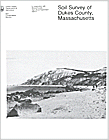The following map unit description is from the published "Soil Survey of Dukes County, Massachusetts"

Soil Survey of
Dukes County Massachusetts
The following map unit description is from the published "Soil
Survey of Dukes County, Massachusetts"

RgA-Ridgebury Variant fine sandy loam, 0 to 3 percent slopes. This soil is nearly level, very deep, and poorly drained and somewhat poorly drained. It is in depressions and low-lying areas adjacent to drainageways in the western part of Martha's Vineyard. The areas of this soil are irregular in shape and range from 5 to 40 acres. They make up less than 1 percent of the survey area.
Typically, the surface is covered with a 3-inch-thick layer of decomposed and undecomposed leaves and twigs. The surface layer is very dark gray fine sandy loam about 2 inches thick. The subsurface layer is light gray fine sandy loam 5 inches thick. The subsoil is light olive brown, mottled silt loam 5 inches thick. The substratum is light brownish gray and light olive brown, mottled, firm silty clay loam to a depth of 60 inches or more.
Included with this soil in mapping are areas of Whitman Variant and Moshup soils. Also included are areas of soils in which the upper part is loamy sand, sand, and gravelly material and small areas of soils with slopes of 3 to 8 percent. In a few areas stones and boulders cover 1 to 3 percent of the surface. Included areas make up about 30 percent of this unit.
The permeability of this Ridgebury Variant soil is slow to moderate in the subsoil and slow or very slow in the substratum. Available water capacity is high. A seasonal high water table is at or near the surface in late fall, in winter, in spring, and after periods of heavy rainfall.
Most areas of this soil are in woodland. Some areas are used for pasture.
This soil is suited to cultivated crops. The seasonal high water table is the main limitation. Surface drainage, diversions, or tile drains or a combination of those practices will help to remove the excess water. Conservation tillage and mixing crop residue and animal manure into the soil will help to improve tilth.
This soil is suited 'to grasses and legumes for hay and pasture. Because of the seasonal high water table, drainage generally is needed and water-tolerant plants are generally more suitable. Using proper stocking rates, rotational grazing, and prevention of grazing when the soil is wet help to maintain desirable plant species and prevent surface-layer compaction.
This soil is poorly suited to woodland productivity. The seasonal high water table causes a high rate of seedling mortality. Low soil strength limits the use of equipment and restricts equipment use to periods when the soil is dry or frozen. The common trees on this soil are red maple and tupelo.
The seasonal high water table limits the use of this soil as a site for dwellings and septic tank absorption fields. The permeability in the substratum further limits the soil as a site for septic tank absorption fields.
This unit is in capability subclass IVw.
RsA-Ridgebury Variant fine sandy loam, 0 to 3 percent slopes, very stony. This soil is nearly level, very deep, and poorly drained and somewhat poorly drained. It is in depressions and low-lying areas adjacent to drainageways in the western part of Martha's Vineyard. Stones and boulders cover 1 to 3 percent of the surface area. The areas of this soil are irregular in shape and range from 5 to 40 acres. They make up less than 1 percent of the survey area.
Typically, the surface is covered with a 3-inch-thick layer of undecomposed and decomposed leaves and twigs. The surface layer is very dark gray fine sandy loam about 2 inches thick. The subsurface layer is light gray fine sandy loam about 5 inches thick. The subsoil is light olive brown, mottled silt loam about 5 inches thick. The substratum is light brownish gray and light olive brown, mottled, firm silty clay loam to a depth of 60 inches or more.
Included with this soil in mapping are areas of Whitman Variant and Moshup soils. Also included are areas of soils in which the upper part is loamy sand, sand, and gravelly material and small areas of soils with slopes of 3 to 8 percent. In a few areas stones and boulders cover 3 to 15 percent of the surface. Included areas make up about 30 percent of this unit.
The permeability of this Ridgebury Variant soil is slow to moderate in the subsoil and slow or very slow in the substratum. Available water capacity is high. A seasonal high water table is at or near the surface in late fall, in winter, in spring, and after periods of heavy rainfall.
This soil is poorly suited to cultivated crops and to hay and pasture. The seasonal high water table and the stones and boulders on the surface are the major limitations.
Most areas of this soil are wooded, but the soil is poorly suited to woodland productivity. The seasonal high water table causes a high rate of seedling mortality. Low soil strength limits the use of equipment and restricts equipment use to periods when the soil is dry or frozen. The common trees on this soil are red maple and tupelo.
The seasonal high water table limits the use of this soil as a site for dwellings and septic tank absorption fields. The permeability in the substratum further limits the soil as a site for septic tank absorption fields.
This unit is in capability subclass VIIs.